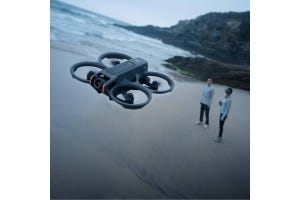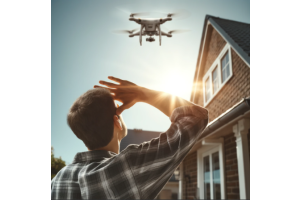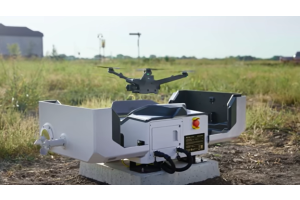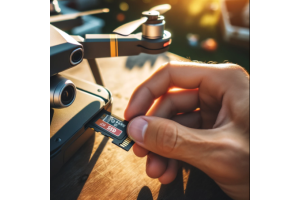When it comes to tools for police work, most people would immediately think gun, patrol car, radio. But what about drones?
Drones are quickly becoming a widely used tool by many public safety agencies. Fire Departments, Emergency Management Services, and yes Police Departments. If you live in a large city, there’s a high chance you’ve seen police helicopters in the sky before. The cost of owning and operating a manned helicopter is high, now imagine that large noisy expensive helicopter being replaced by a much smaller, quieter, and less costly aircraft. That aircraft is a drone.

Image courtesy Wikipedia
“Manned helicopters and fixed-wing aircraft are expensive to acquire, staff, and maintain. A police helicopter costs from $500,000 to $3 million to acquire, and $200-$400 an hour to fly.” – PoliceOne.com
Compare the above statement with a (rough) initial cost of $15k for the average police department UAV system, and the fact that operational costs are only the relatively small amount of electricity needed to charge the batteries as well as the salary of the pilot. There isn’t any jet fuel (cost as of 8/21/17 at LAX is $7.87 a gallon), and as of July 2017 electricity in Los Angeles is around 18¢ per kWh (for reference, charging a large drone battery with a capacity of 12,800 mAh is around 280 Wh meaning it costs roughly 4¢ to charge a 12,800 mAh battery). The numbers in that example are significantly higher than the cost for an average drone as well since the largest battery DJI offers is the TB55 at 7,660mAh. An LA Times article claims an LAPD helicopter used for a community outreach flight cost $771, which is more than the purchase cost of two TB55 batteries.
Enough about the cost. The real benefit to police departments is greater than the simple numbers. Ease of use and officer safety are the real keys.
Ease of use
The average training time for a civilian helicopter pilot is between 40-50 hours. Most people can learn to fly a GPS-stabilized drone within an hour. The setup time to deploy a drone is only a couple of minutes (check out our video below to see the deployment workflow for a Matrice 200), and it doesn’t have to be deployed from a remote location meaning a drone can be in the air monitoring a situation well before a helicopter would be able to reach the scene. All of this with a live HD picture, with optical and thermal cameras available- and it will fit in the trunk of a cruiser.
Officer safety
When investigating active shooters, suspects believed to be “armed and dangerous”, or potential HazMat incidents drones can give police safe vantage points to assess the situation while coming up with a strategy for the approach.
We spoke to an officer of a police department without a drone program to see what they thought of police using drones:
“I think it depends on what we use them for, really. If we’re using them for the same type of situations we use the helicopter for, it seems like a fast and efficient way to do it. Having those guys above me on a dangerous call or when we’re searching for someone is great because they can see a lot that I can’t. The biggest downside is we only have one helicopter up at a time.”
They brought up a great point: in situations where multiple vantage points would be advantageous, it’s dangerous with large manned helicopters. Multiple drones can offer many vantage points of the situation with very little risk due to their small size and maneuverability.
Precedent
While still a relatively new idea, police use of drones is becoming more and more prolific.
In January 2016, San Bernardino PD got started on their UAV program. In an article with the SB Sun, Police Chief Jarrod Burguan spoke about the December 2, 2015 terror attack in San Bernardino: ““The only mechanism we had to [inspect the vehicle] was to insert people very close in armored vehicles, and then ultimately they had to get out and look even closer,” he said. “We could very easily fly this thing right up to the window of those trucks and take a look inside the window. Much safer, much less expensive.”
This broadcast from KCRA News shows footage of Police using a drone to catch a fleeing robbery suspect wanted on gun charges in Modesto, CA.
Drones can be used by Police Departments for more than just active situations as well. Mesa County Sheriffs Office in Grand Junction, CO uses their UAV program for assisting in crime scene or accident investigations. This video from the JTIC (Justice Technology Information Center, a program of the National Institute of Justice, Office of Justice Programs, and U.S. Department of Justice) also addresses several key components to starting a UAS program, and how to address the public perception of Police drones as instruments for Police to spy on citizens.
DSLRPros customer and friend Lt William Cox has started a program at his Sheriff’s Office in Bossier, LA. He has also helped other departments in his area start their own. TheDronesMag posted an article about the Bossier Sheriff’s Office UAS program in which they described how they got started with their program and how they use it.
“In March 2017, when three teenage runaways were hiding in the woods at nighttime off of Highway 80 in Princeton in the eastern part of the parish, a Bossier deputy deployed a drone using thermal imaging, and within a minute of launch, he located the three teens.” -TheDronesMag
BUT WAIT, THERE’S MORE!
We understand that there’s more to purchasing a drone for your department than just listing a few benefits. The more informed you are, the more likely city councils and budgeting committees will be to grant access for the purchase. So we’ve put together some references for you.
•Argus Rising*
Argus Rising is a training company that goes all the way for their customers. They are First Responder specific trainers that have courses for all aspects of drones for First Responders, as well as helping create operational manuals and licensing, and also help with information to pitch city council approval.
*We do not have hands-on experience with this company, and only reference this as an option for our customers to look into and decide for themselves if it is right for them.
•Ask Drone U
Drone U is a great website filled with training programs and incredibly useful podcasts. They offer a free membership that grants access to all of their podcasts which we highly suggest taking advantage of. Their “Pro” membership grants access to training programs and is $47 a month. Podcast ADU0548 focused on drone use for Fire and Police departments, including information about authorizations, different uses for drones within the public safety sector, and best options for equipment. Their special guest for this podcast was Keenan Newton of Saving Lives With Drones.
•Read Considerations and Recommendations for Implementing an Unmanned Aircraft Systems (UAS) Program
Provided by the U.S. Department of Justice
•Saving Lives With Drones
In this piece, Keenan Newton goes more in-depth into COA (Certificate of Authorization) and SGI (Special Government Interest [formerly known as Emergency COA]), as well as Public COA vs Part 107. Their website also has quick links to several resources for the safe operation of drones.








